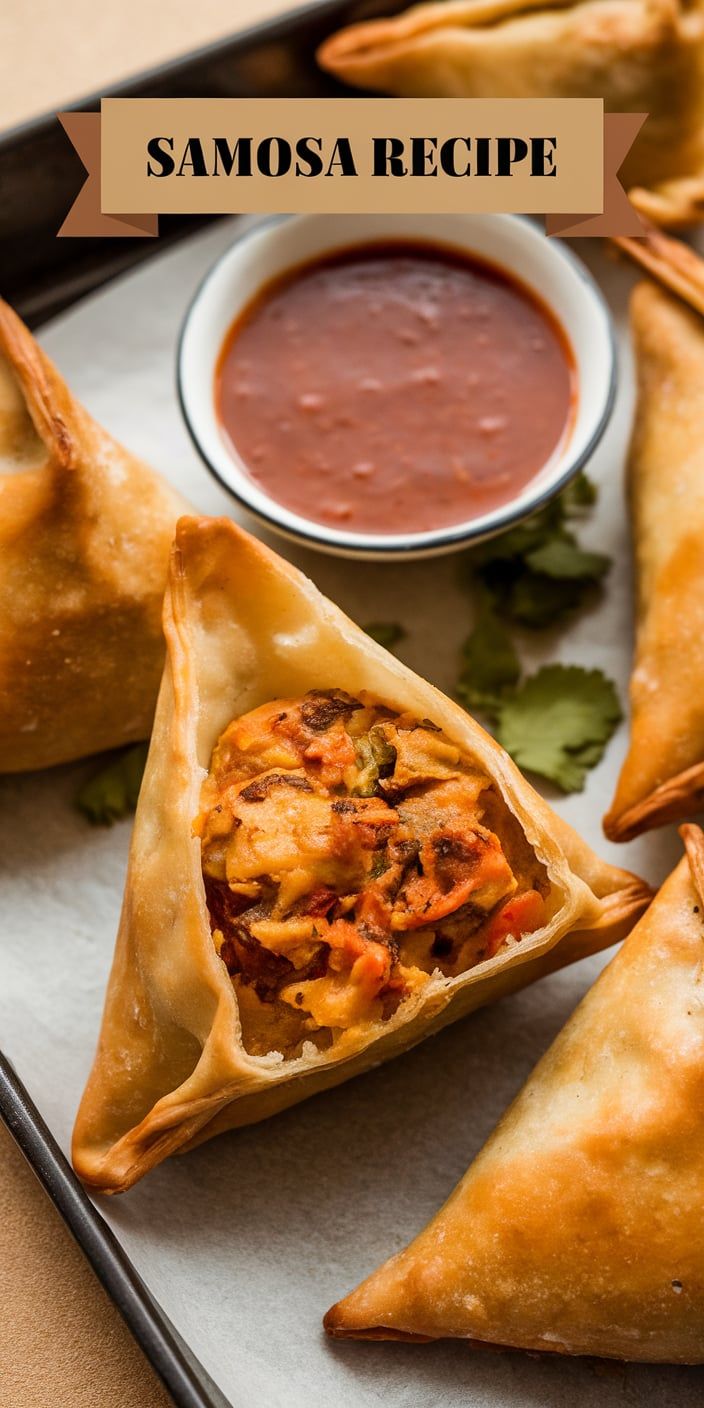Discovering the perfect samosa recipe has been a delightful culinary journey for me. These golden, crispy triangles of pure deliciousness are more than just a snack – they’re a celebration of Indian cuisine packed with incredible flavors and textures.
As a passionate home cook, I’ve perfected my homemade samosas to bring authentic taste straight to my kitchen. This Indian appetizer isn’t just food; it’s an experience that connects culture, tradition, and pure gastronomic joy.
My samosa recipe transforms simple ingredients into remarkable street food that will transport your taste buds directly to the vibrant streets of India. Whether you’re hosting a party or craving a delectable snack, these crispy pastries filled with spiced potatoes and peas are guaranteed to impress.
Get ready to embark on a culinary adventure that will make you fall in love with one of the most beloved Indian appetizers. We’ll explore every detail of creating the perfect homemade samosas from scratch.

Why I Love Making Homemade Samosas
Cooking samosas at home has become my absolute passion. The benefits of homemade samosas go far beyond just creating a delicious snack. My kitchen transforms into a culinary playground where I can experiment with flavors and perfect my samosa cooking tips.
What makes homemade samosas special is the complete control I have over ingredients. Store-bought versions pale in comparison to the fresh, vibrant flavors I can create from scratch. I love selecting high-quality spices and fresh vegetables that bring authentic taste to every bite.
- Full control over ingredient quality
- Customize spice levels to personal preference
- Healthier alternative to pre-made samosas
- Opportunity to explore traditional Indian cooking techniques
My samosa cooking tips have evolved through years of practice. Understanding the perfect dough consistency and mastering the art of folding takes patience. Each batch becomes a delightful learning experience that connects me to a rich culinary tradition.
Sharing these crispy, golden triangles with friends and family brings me immense joy. The smiles and appreciative comments make every minute of preparation worthwhile. Homemade samosas are more than just a snack – they’re a celebration of flavor, creativity, and love.
Essential Ingredients for Perfect Samosas
Creating authentic samosas requires carefully selected samosa ingredients that bring together incredible flavors and textures. I’ll walk you through the precise components needed to craft these delectable Indian pastries that will impress your family and friends.
Crafting the perfect samosa is an art that begins with understanding the key samosa ingredients and their unique roles in the recipe. From the crispy exterior to the spiced filling, each element plays a crucial part in delivering an unforgettable culinary experience.
Pastry Dough Components
The foundation of any great samosa is its dough. My samosa dough recipe requires simple yet specific ingredients:
- All-purpose flour (2 cups)
- Salt (1 teaspoon)
- Vegetable oil (4 tablespoons)
- Warm water (as needed)
Potato Filling Ingredients
The heart of samosas lies in their flavorful potato filling. Here are the key ingredients:
- Potatoes (4 medium-sized)
- Green peas (1/2 cup)
- Onions (1 medium, finely chopped)
- Ginger (1 tablespoon, minced)
Spice Blend Requirements
Samosa spices are what truly elevate these pastries from good to extraordinary. My signature spice blend includes:
| Spice | Quantity |
|---|---|
| Cumin powder | 1 teaspoon |
| Coriander powder | 1 teaspoon |
| Garam masala | 1/2 teaspoon |
| Red chili powder | 1/4 teaspoon |
Each ingredient in this carefully curated list contributes to creating samosas that burst with authentic Indian flavors. The combination of crisp dough, spiced potato filling, and aromatic spices ensures a truly memorable culinary experience.
Kitchen Tools and Equipment Needed
When preparing to make delicious samosas, having the right samosa making tools can make a significant difference in your cooking experience. I’ve compiled a comprehensive list of kitchen equipment for samosas that will help you create perfect crispy treats every time.
Essential kitchen tools for samosa preparation include several key items that will streamline your cooking process:
- Large mixing bowl for preparing dough and filling
- Rolling pin for creating thin, even pastry sheets
- Sharp knife or pastry cutter for precise dough shaping
- Deep frying pan with high sides for safe oil cooking
- Slotted spoon for removing samosas from hot oil
- Kitchen thermometer to monitor oil temperature
I recommend investing in a few specialized samosa making tools that can elevate your cooking experience. A triangular samosa mold can help create uniform shapes, while a pastry brush ensures even egg wash application for golden crusts.
| Tool Category | Recommended Items | Purpose |
|---|---|---|
| Preparation Tools | Mixing bowls, rolling pin | Dough and filling preparation |
| Shaping Tools | Pastry cutter, samosa mold | Creating uniform samosa shapes |
| Cooking Equipment | Deep frying pan, thermometer | Safe and precise cooking |
Don’t worry if you lack specialized kitchen equipment for samosas. Many home cooks successfully make samosas using basic kitchen tools and a bit of creativity. The most important aspects are precise technique and quality ingredients.
Samosa Recipe: Step-by-Step Instructions
Creating delicious homemade samosas requires patience and practice. I’ll walk you through the entire process of how to make samosas, from preparing the perfect dough to crafting a mouthwatering filling that will impress your friends and family.
Crafting the Perfect Dough
Start by mixing your dry ingredients for the samosa dough. You’ll need:
- 2 cups all-purpose flour
- 1/2 teaspoon salt
- 4 tablespoons vegetable oil
- Water for kneading
Mix the flour and salt, then incorporate the oil until the mixture resembles coarse breadcrumbs. Gradually add water to create a firm, smooth dough. Knead for 5-7 minutes until elastic, then cover and rest for 30 minutes.
Preparing the Spiced Filling
For an authentic samosa filling recipe, you’ll need:
- 4 medium potatoes, boiled and mashed
- 1/2 cup green peas
- 2 tablespoons ginger-garlic paste
- 1 teaspoon cumin seeds
- Garam masala and salt to taste
Sauté the spices, then mix with mashed potatoes and peas. Cook until the mixture is dry and well-seasoned.
Mastering Samosa Folding Techniques
Rolling and folding samosas is an art form. Cut the dough into small circles, then fold into a cone shape. Fill with the potato mixture, seal edges with water, creating a triangular shape. The key is ensuring tight seals to prevent filling from leaking during frying.
Pro tip: Practice makes perfect when learning samosa folding techniques. Don’t get discouraged if your first attempts aren’t picture-perfect!
Tips for Deep Frying to Golden Perfection
Achieving the perfect crispy samosa requires mastering the art of deep frying. I’ll share my top techniques to ensure your samosas turn out golden and delicious every single time.
The key to crispy samosa tips starts with selecting the right oil and maintaining the correct temperature. Vegetable or canola oil works best for deep frying samosas. You’ll want to heat the oil to exactly 350-375°F for optimal results.
- Use a deep-fry thermometer to check oil temperature
- Avoid overcrowding the frying pan
- Fry samosas in small batches for even cooking
- Drain excess oil on paper towels after frying
I recommend testing the oil’s readiness by dropping a small piece of dough into the pan. If it sizzles and rises immediately, the oil is perfect for deep frying samosas. Rotate the samosas gently while frying to ensure a uniform golden-brown color.
Safety is crucial when deep frying. Always use a long-handled spider strainer or slotted spoon to carefully place and remove samosas from hot oil. Wear protective kitchen gloves and keep a fire extinguisher nearby as a precaution.
For those seeking a healthier alternative, baking samosas at 425°F for 20-25 minutes can provide a crispy exterior with less oil. Brush the samosas with a light egg wash or oil to help achieve that golden crunch.
Best Dipping Sauces and Accompaniments
No samosa is complete without the perfect dipping sauce. I’ve discovered that samosa dipping sauces can transform an already delicious snack into a culinary experience. The right condiment brings out the crispy texture and spicy filling, creating a flavor explosion that will impress your guests.
I’ll share three incredible sauce recipes that will elevate your samosa game. Each sauce offers a unique flavor profile that complements the crispy pastry and savory filling.
Traditional Mint Chutney Recipe
My mint chutney recipe is a classic accompaniment that brings freshness to samosas. Here’s what you’ll need:
- 1 cup fresh mint leaves
- 1/2 cup fresh cilantro
- 2 green chilies
- 1 inch ginger
- 2 tablespoons lemon juice
- Salt to taste
Blend all ingredients until smooth. The result is a vibrant green sauce that cuts through the richness of the samosas.
Sweet Tamarind Sauce for Samosas
My tamarind sauce for samosas adds a tangy-sweet dimension that people love. The ingredients are simple:
- 1/2 cup tamarind paste
- 1/4 cup jaggery or brown sugar
- 1 teaspoon cumin powder
- 1/2 teaspoon red chili powder
- Salt to taste
Mix all ingredients and simmer until it reaches a syrupy consistency. The sauce provides a perfect balance of sweet and tangy flavors.
Spicy Ketchup Variation
For those who prefer a quick option, I recommend a spicy ketchup that takes just minutes to prepare:
- 1/2 cup tomato ketchup
- 1 tablespoon hot sauce
- 1/2 teaspoon red chili flakes
Simply mix the ingredients for an instant kick of flavor that complements crispy samosas.
| Sauce Type | Flavor Profile | Preparation Time |
|---|---|---|
| Mint Chutney | Fresh, Tangy | 10 minutes |
| Tamarind Sauce | Sweet, Spicy | 15 minutes |
| Spicy Ketchup | Bold, Zesty | 5 minutes |
Storage and Reheating Methods
I’ve discovered some fantastic techniques for storing and reheating samosas that will help you preserve their delicious crispy texture. When it comes to how to store samosas, refrigeration is your best friend for short-term storage. Place your leftover samosas in an airtight container, separating layers with parchment paper to prevent sticking. They’ll stay fresh in the refrigerator for up to 3-4 days.
Freezing is an excellent option for long-term storage of leftover samosas. Wrap each samosa individually in plastic wrap, then place them in a freezer-safe container or zip-top bag. When you’re ready to enjoy them, reheating samosas is simple. I recommend thawing frozen samosas in the refrigerator overnight before reheating to maintain their quality.
For the crispiest results, oven reheating is my top method. Preheat your oven to 350°F and place samosas on a baking sheet lined with parchment paper. Bake for 10-15 minutes, turning once halfway through to ensure even heating. If you’re short on time, an air fryer works wonderfully too, giving you that fresh-from-the-fryer crunch in just 3-4 minutes at 350°F.
Pro tip: Avoid microwave reheating if possible, as it can make the pastry soggy. If you must use a microwave, place a paper towel under the samosas and heat in short 15-second bursts to minimize moisture buildup. With these storage and reheating methods, you’ll enjoy delicious samosas that taste almost as good as when they were first prepared!
